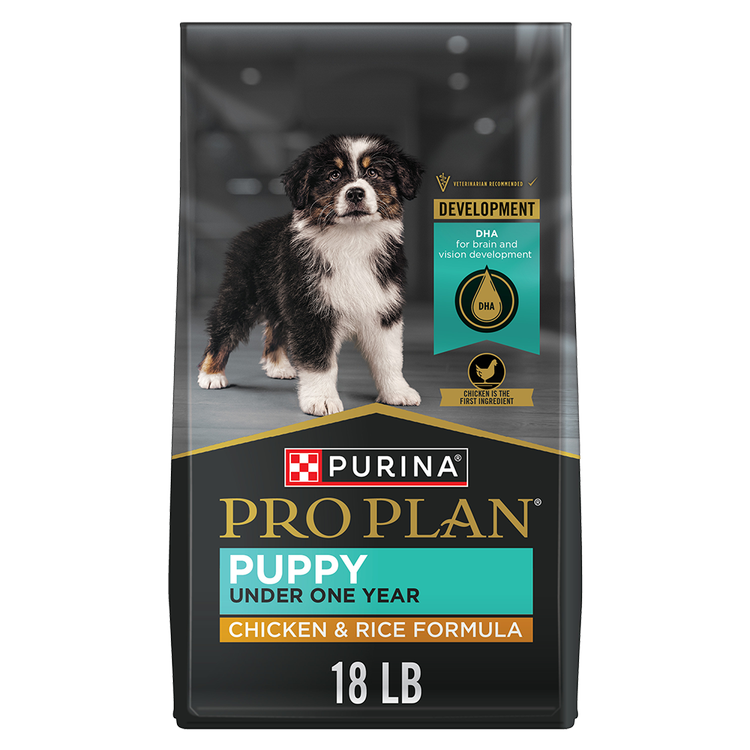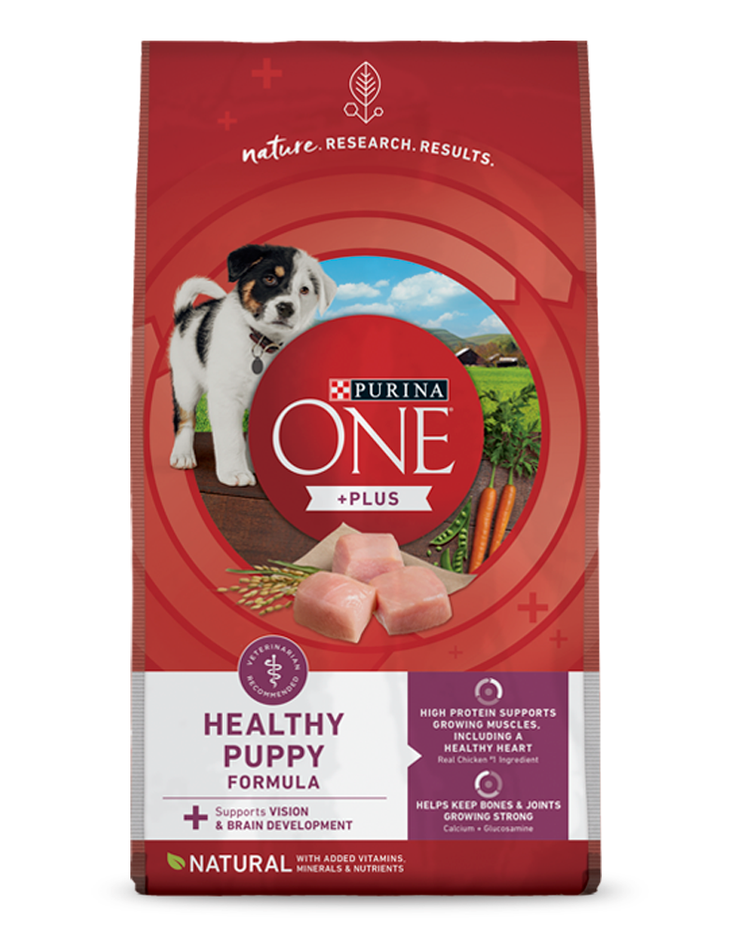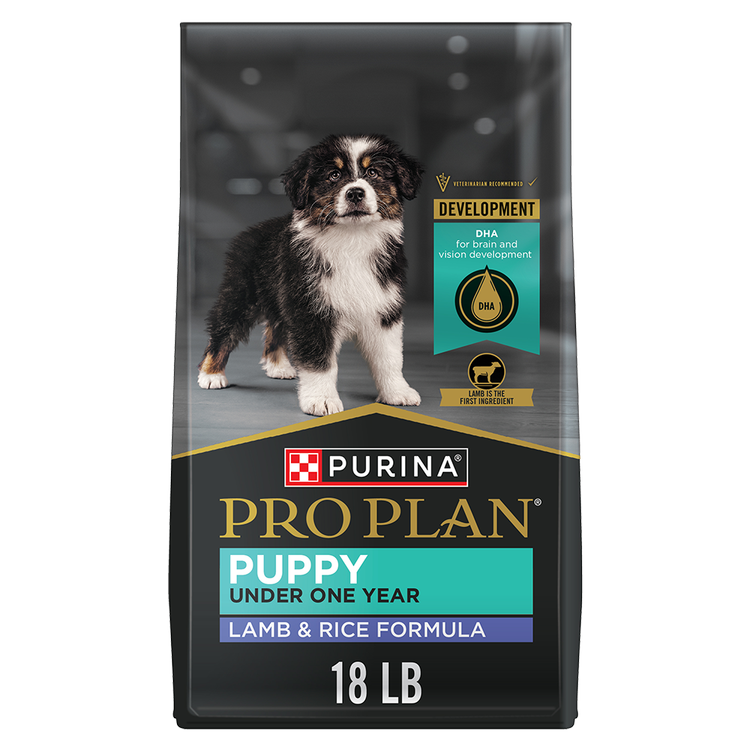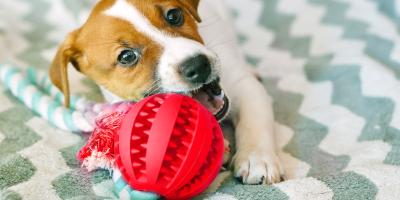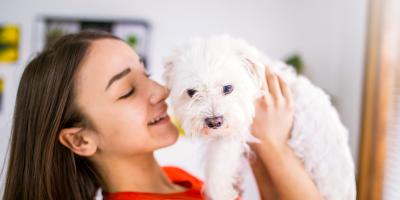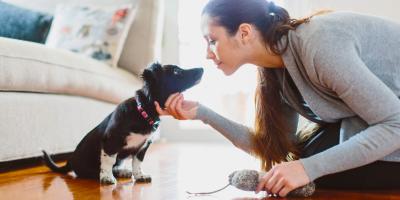Basic Puppy Training: When & How to Train Your Puppy

Puppy training is a great opportunity to bond with your young dog. It might not always go smoothly, but through the process, you’ll build a companionship with trust that lasts throughout your dog’s life.
Additionally, training at an early age increases the chances that your young pet becomes a well-socialized, confident and obedient adult dog.
The most important steps in basic puppy training are to start early, keep calm, be consistent, stay positive and repeat.
Here are some useful tips and insights to help you achieve puppy training success. (You can also find puppy training guidance on the myPurina app.)
When to Start Training a Puppy
The best time to start training your puppy is the moment they enter your home. Show them right from wrong the first day and continue to teach them the rules as they grow up.
Remember that training doesn’t just happen during training sessions but with every interaction you have with your puppy.
If you miss something along the way, that’s okay. You can indeed teach an old dog new tricks. Meanwhile, if you run into any problems or have any questions during training, reach out to your veterinarian.
How to Start Training a Puppy
If you’re ready to start your puppy training, keep these tips in mind.
Be Consistent
To create a strong connection between you and your puppy, be clear and consistent with communication when training them. Otherwise, they’ll get confused.
Remember, if you’re not consistent, you can’t expect your puppy to be either.
Be Patient
Your puppy will likely need some time to learn the ropes. Don’t forget that, in addition to learning behaviors, they’re figuring out how to navigate the world.
Use Positive Reinforcement
Giving your puppy a treat or dry kibble can be an excellent way to reinforce correct behavior and encourage them (just be mindful of their daily caloric intake). But don’t give them any free rides. They need to earn that treat, even if all you’re asking is for them to look at you or come toward you to get it.
It’s okay to start with treats, but gradually replace them with praise. Pretty soon, praise will be all they need, and treats can be just that—a treat.
Make Training a Group Effort
Dogs are social animals naturally accustomed to living in packs. So, it can be helpful for your puppy if everyone in your home (or “pack”) assists with training and uses the same cues.
Correcting Puppy Behavior
Misbehavior from your puppy is expected, but it isn’t out of spite. Instead, puppy misbehavior usually stems from their belief that the way they’re acting is okay. It’s up to you to teach them what appropriate behavior looks like.
Puppies live in the present, so don’t bother attempting to give them feedback on something that occurred in the past. Instead, focus on communicating clearly in the moment by praising them for good behavior and redirecting unwanted behavior.
For example, when your puppy jumps up on people, ask for eye contact and reinforce the good behavior. Then, ask for a sit and reinforce this as well.
Puppy-Training Cues
Training your puppy starts by encouraging them when they do something you like, reinforcing the desired behavior with plenty of praise and treats, or a toy. Then, you can teach a cue that they associate with that behavior, such as “Sit.”
Be sure to praise them calmly so as not to overexcite and distract them.
Keep Training Sessions Brief
Given their short attention spans, puppies can only learn so much at once. Try to limit your training sessions to no more than 10 minutes at a time. There can be multiple sessions per day.
How Long Does it Take to Train a Puppy?
Every puppy learns at their own pace. One dog might pick up cues in a couple weeks while another needs months to master them. It can be frustrating if your dog isn’t learning as fast as you’d like, but try not to get attached to a specific time line for training.
What Are the First Things to Teach Your Puppy?
Puppies can begin learning from you at around eight weeks of age. You might be wondering, “What is the first thing you should train your puppy to do?” As you start puppy training, there are a few important skills you can teach them right away:
- How to walk on a leash
- How to sit
- How to interact with people and pets in your home
What Should Your Puppy Know by 6 Months?
By six months of age, many puppies can be trained in the following areas:
- Potty training
- Crate training
- The “Come” command
- Learning not to bite
What Should Your Puppy Know in the First Year?
At one year old, your puppy may be able to learn these commands:
When to Start Puppy Training Classes
Puppies can begin socialization classes as early as seven-to-eight weeks of age. It’s recommended they receive their appropriate vaccines before starting a class, however.
At this early age, puppy classes typically focus on play, as socialization is key to their development.
How to Train a Puppy – Basic Commands
Here are basic behaviors (and instructions) to help make your puppy training successful.
How to Teach Your Puppy to Sit
- Start by making eye contact with your puppy.
- With the puppy standing, hold a treat or kibble in front of their nose. This is called luring.
- Move the treat or kibble over their head towards their back, creating a natural sit. Move slowly and keep the treat or kibble directly in front of their nose.
- When the puppy’s rear hits the ground, reinforce the behavior with a treat or kibble and praise them.
- Once the puppy is reliably following the treat or kibble into a sit, you can then start using your empty hand in the same movement. Always reinforce the behavior with a treat or kibble and praise.
- When the puppy is consistently sitting without the treat or kibble, add a verbal cue, such as “Sit.” The verbal cue should be said before you motion the puppy to sit with your hand.
How to Teach Your Puppy to Stay
- Start with your puppy in a neutral position they already know, such as a sit, down or even stand.
- Once they’re sitting, put your hand flat in front of their face and give the cue: “Stay.”
- Take one step back from your puppy while facing them.
- If your puppy gets up, step back toward them. (If the puppy has a hard time, have them get up on a dog-safe pedestal. After they master the behavior on the pedestal, then start training on the ground.)
- If your puppy remains sitting, take a step forward to reinforce the stay.
- Repeat until they stay consistently.
- Next, try taking two steps back. If your puppy follows you, go back to taking one step. Gradually increase the distance over time while using the cue, “Stay.”
- “Release” your puppy by using a release word, like “Free” or “Break,” to let them know that they’re done with the behavior.
- Remember to praise (and treat, if needed) but do it calmly.
How to Teach Your Puppy “Down”
- Start by making eye contact with your puppy.
- Have your puppy sit.
- Hold a small treat or piece of kibble in front of your puppy’s nose.
- Move the food down to the ground, just in front of their front paws, then pull the treat slowly out along the ground, as if you’re drawing an “L” with the treat. With food in your hand, your puppy is likely to follow.
- As your puppy lies down, praise them calmly. After several sessions, add the verbal cue “Down.”
- Over time, you can pair this cue with other cues, like “Stay.”
How to Teach Your Puppy Their Name
- Choose a moment when your dog is not paying attention to you, and then say their name in a happy, encouraging tone.
- Once they look at you or acknowledge that you’re speaking to them, reinforce their behavior with praise while giving them a toy or a treat.
- Once your puppy learns to respond consistently to their name, try calling them from a different room or a further distance away.
- Remember to call them by their name whenever you cuddle or play with them.
How to Teach Your Puppy Loose Leash Walking
- If you can, burn off excess energy by playing with your puppy before going for a training walk.
- Begin by putting the leash on your dog and standing still. Try to choose an area free from distractions. When your dog stops pulling on the leash, reinforce this behavior with a treat or kibble.
- Walk a few steps and allow your puppy to walk along with you, then stop and wait for them to stop pulling on the leash, or sit and offer them a treat to reinforce no pulling.
- Continue this strategy until your puppy realizes that staying by your side as you walk or stop with a slack leash is the desired behavior.
- Praise them warmly when they follow the desired behavior.
- Continue walking, but try moving at a faster pace with sudden turns to the right or left to keep things interesting. Anytime they pull on the leash, remember to stop until they have calmed down, then give them positive reinforcement.
Can You Train a Dog Even if They’re Not a Puppy?
It’s recommended that you train your dog while they’re young. However, if your puppy fails to completely grasp parts of their training, or you adopt an older dog who wasn’t trained as a puppy, there’s still hope.
Obedience training for older dogs can be successful. Adult canines may need more time to adapt to a new routine, but their longer attention spans can make them capable learners.
If training doesn’t seem to be working or you have training questions, seek the assistance of a qualified puppy trainer or behavior professional.
For more helpful training insights, check out the myPurina app.
For more expert tips on training your pet, explore our puppy training page.
For your own personalized dog training plan, download Zigzag, the most advanced dog training app, for free and unlock 1 month of Premium Access with unlimited lessons, tailored guidance, and 24/7 expert support using code PUR30 at payment.
Install Zigzag for free now to get started

Be Rewarded for Your Purina Purchases
Earn and redeem points for Purina products with myPurina app.

